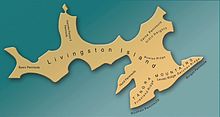



Varna Peninsula (Bulgarian: полуостров Варна, romanized: poluostrov Varna, IPA: [poɫuˈɔstrov ˈvarnɐ]) is a roughly rectangular predominantly ice-covered peninsula forming the northeast extremity of Livingston Island in the South Shetland Islands, Antarctica. It is bounded by Hero Bay to the northwest, by Moon Bay to the southeast, and by McFarlane Strait to the northeast.
The peninsula is approximately 14 km long in the southwest–northeast direction and 10 km wide, with a central area occupied by Vidin Heights. The north and east extremities of Varna Peninsula are formed by Phelps Promontory and Williams Point, and by Inott Point respectively. The coast is indented by Lister Cove and Dragon Cove to the northeast, and by Griffin Cove, Charybdis Cove and Eliseyna Cove to the northwest. Bezmer Point is also on the northwest coast of the peninsula.
The area was visited by early 19th century sealers. Williams Point was the first land discovered in the Antarctic Treaty area, by the British navigator William Smith on 19 February 1819.
Varna is the name of a major city on the Bulgarian Black Sea Coast. This is one of the Bulgarian names bestowed on previously nameless geographical features by the Tangra 2004/05 Expedition.